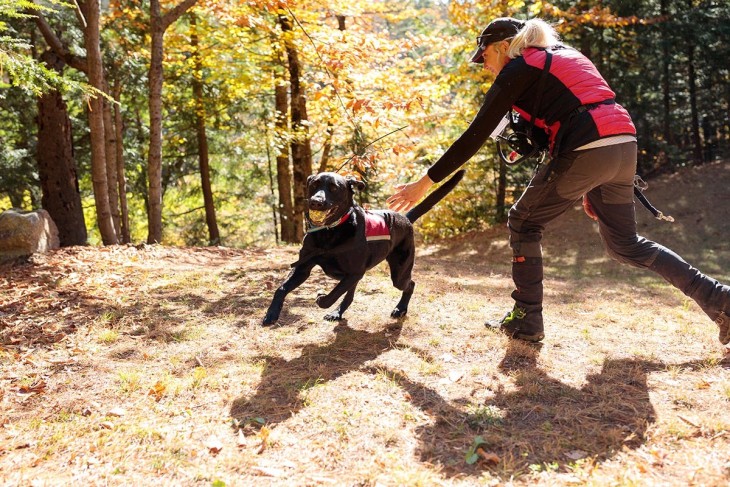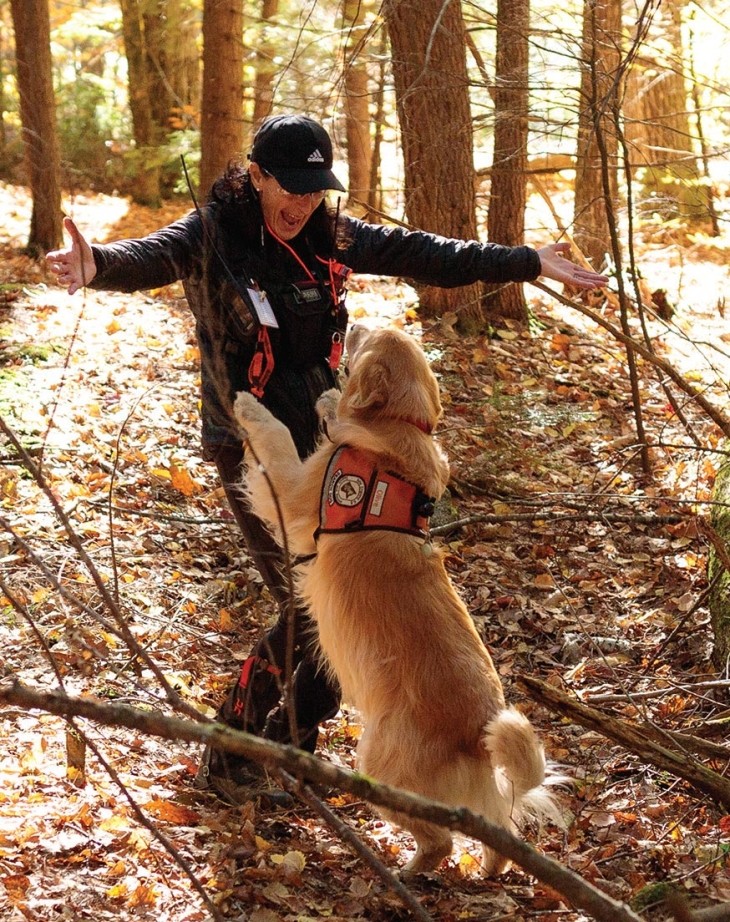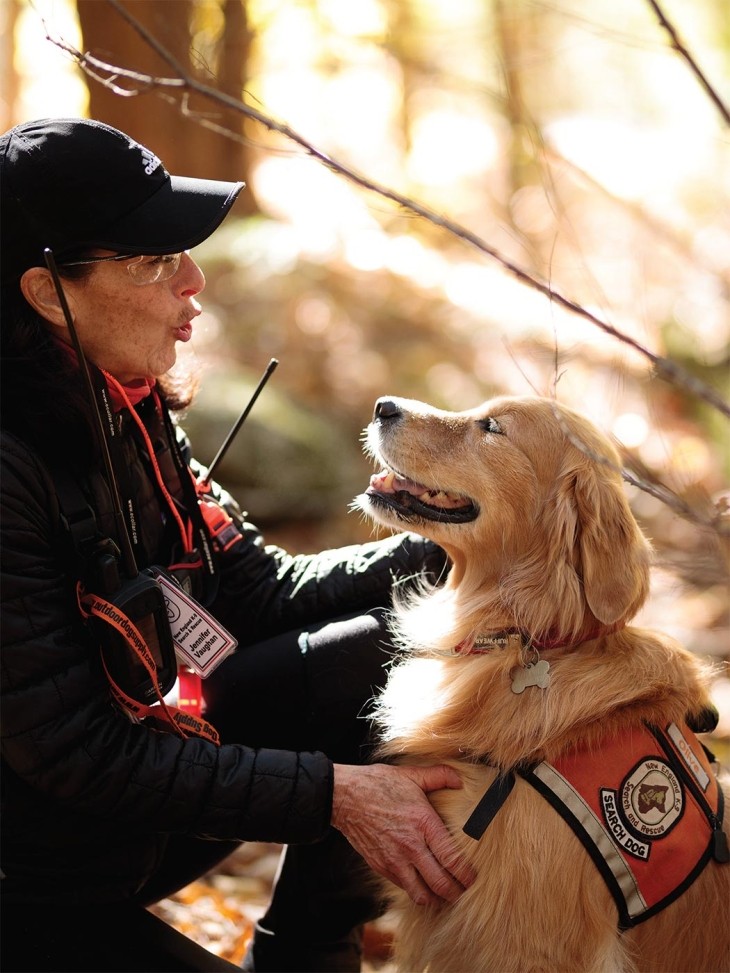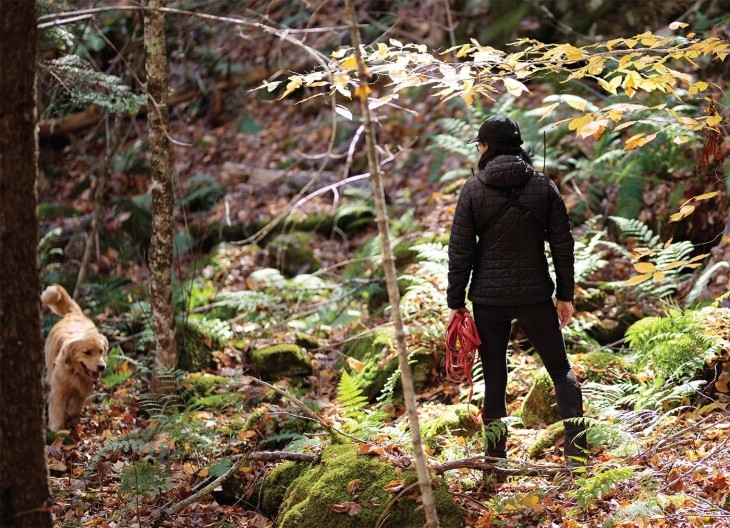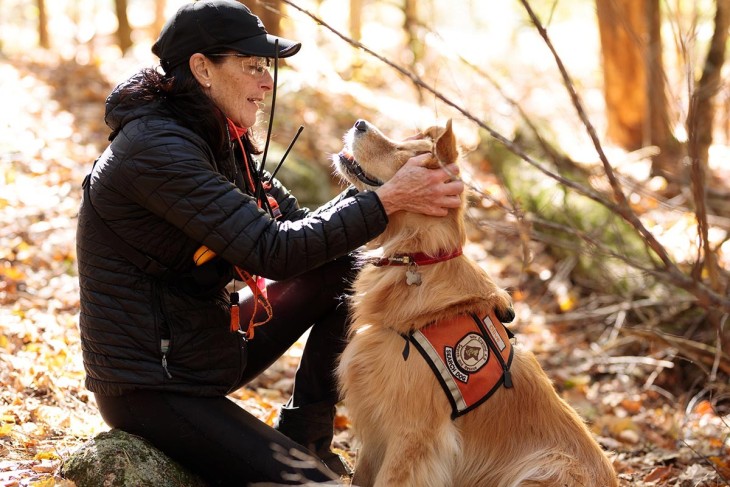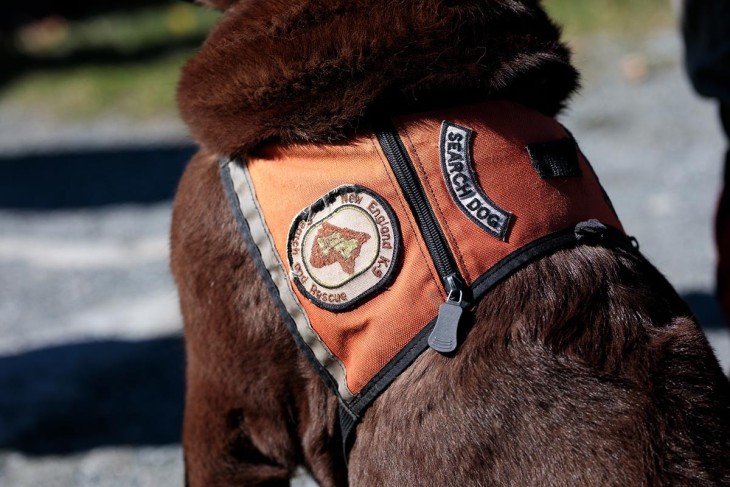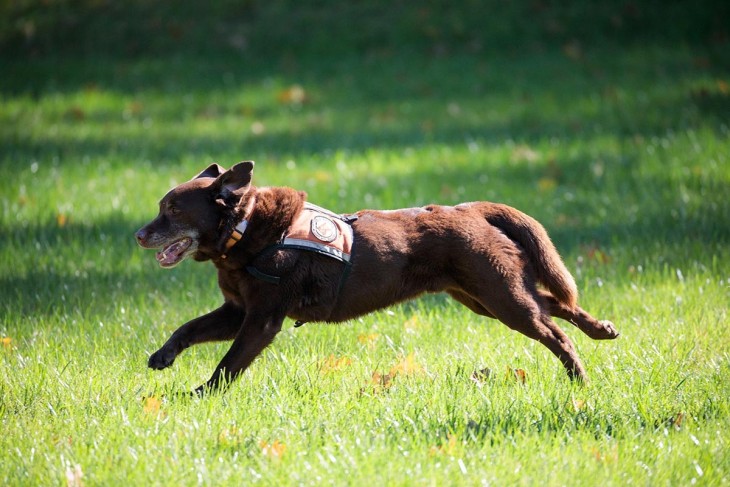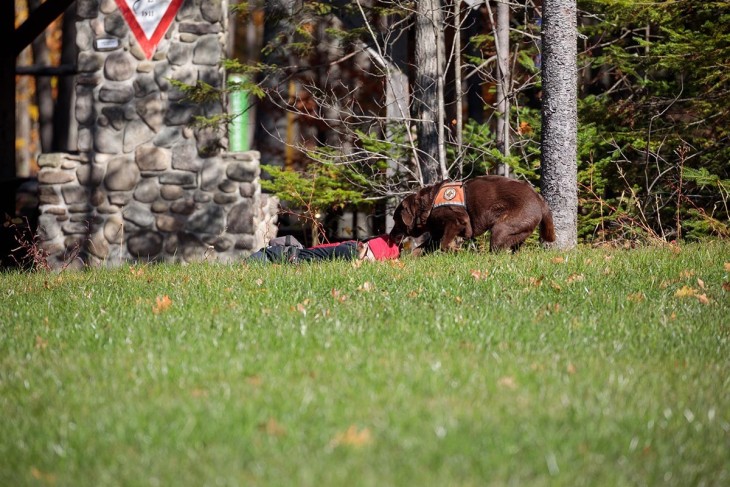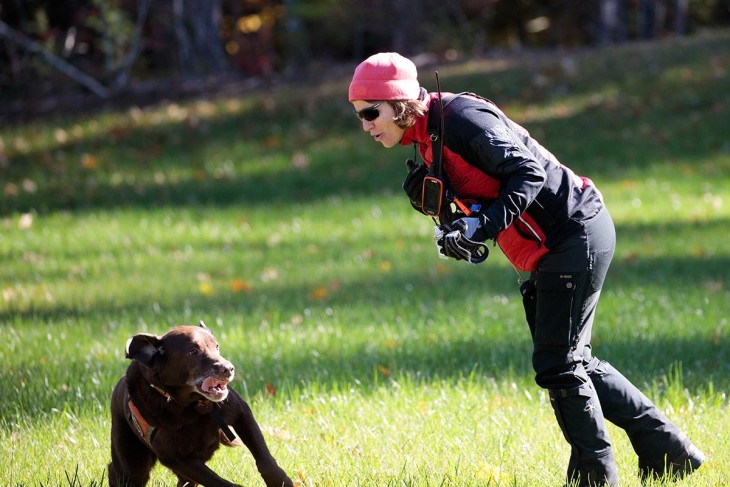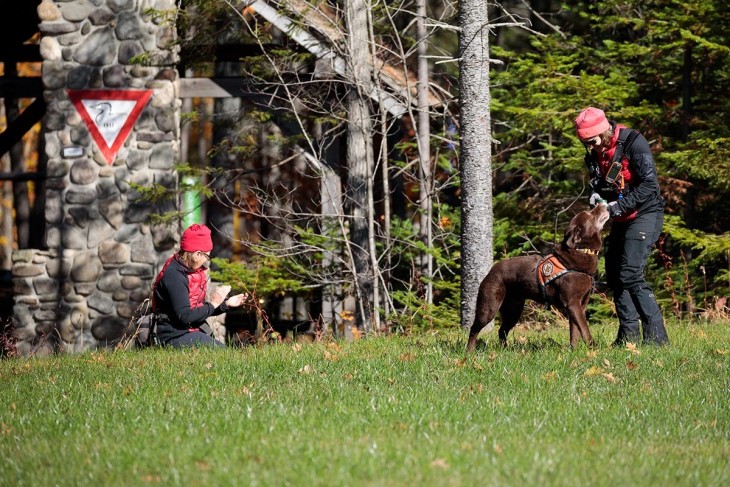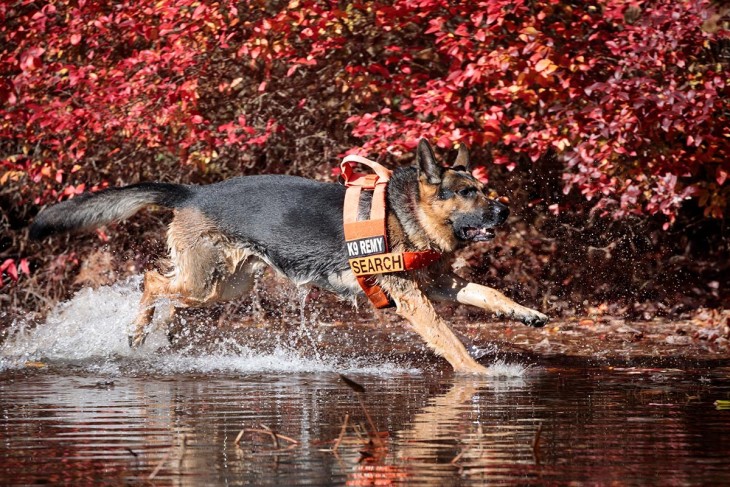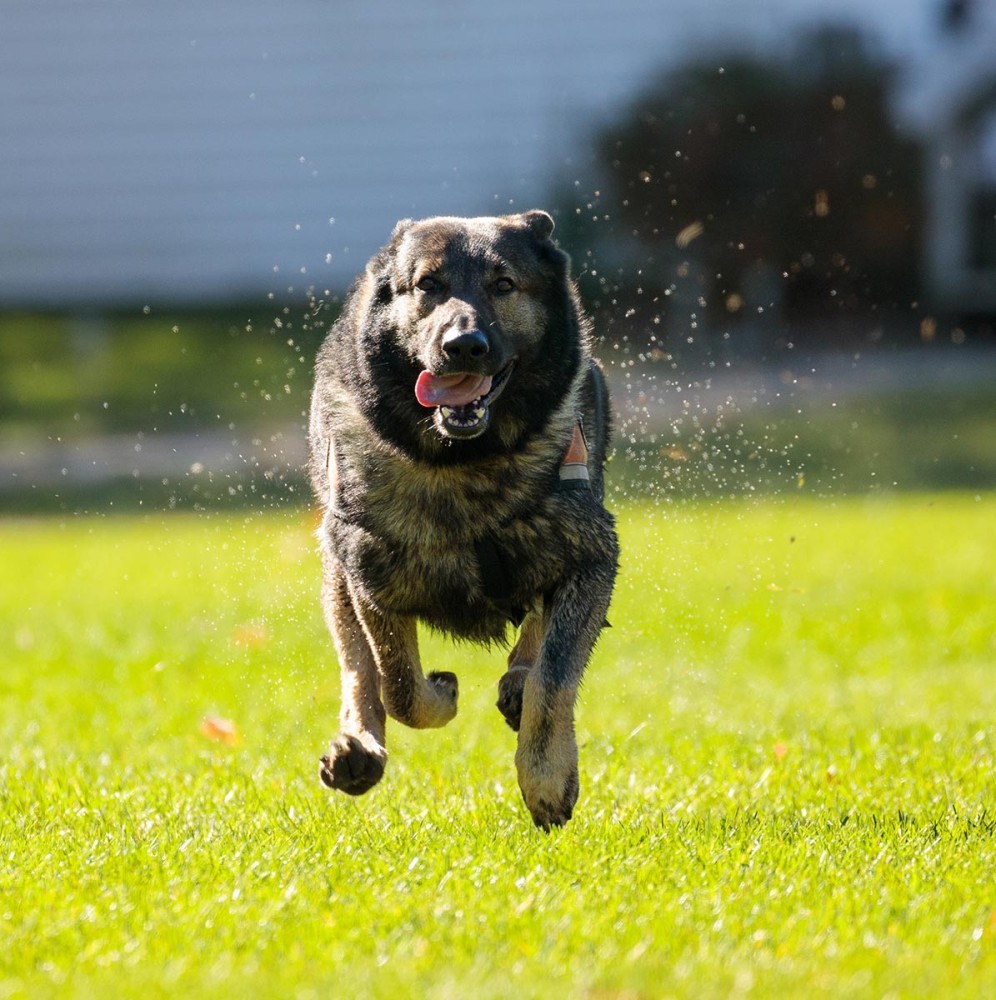
When Vermont State Police and the New Hampshire Fish and Game Department need to search the woods, they call on this special group of air scent dogs and their handlers. The keys to NEK9’s success: a stringent certification process, constant training, and a passion for squeaky toys.
Ryker seems happy as he moves through the woods, eyes bright, tail up, human companion nearby. The German shepherd wears an orange vest wrapped across his midsection and a GPS collar looped around his fuzzy neck. He trots ahead of his handler, Donna Larson, circling back now and then to check in as she sets the general path they follow – sometimes along an ATV trail, but mostly through forest and scrubby brush.
Larson and Ryker are members of New England K-9 Search and Rescue – also known as NEK9 – an all-volunteer team that works with law enforcement agencies in New Hampshire and Vermont to locate lost and missing people. Today, the duo is conducting a training search. They’re trying to find another team member, Jeanne Menard, who has hidden herself within a designated grid in the woods.
Larson steers Ryker back and forth within the grid, up hills, through dense undergrowth and more sparsely spaced trees, and down into hollows. Every few minutes, Larson checks a handheld GPS device to review the ground they’ve covered and to ensure they’re within the boundaries of the area they’ve been assigned to search. Occasionally, she stops to blow a loud whistle and calls out, listening for Menard’s voice. At these times, Ryker pauses, his black ears upright and alert.
Sound is important on this day, as there is little movement of the air to carry scent. After close to an hour of searching, the German shepherd hears a faint response to one of Larson’s calls. He picks up the pace toward the sound, skirts the edge of a swampy pond, runs ahead, and then sprints back and jumps excitedly onto Larson, pushing against her chest with his front paws.
“Show me!” she tells him. Ryker turns again toward Jeanne Menard, who is lying 50 yards away behind a fallen log, acting the part of a scared, injured search subject. As he runs, Ryker turns now and then to make sure Larson is keeping up. When he reaches Menard, Ryker looks every part the proud pup. He pants. He prances.
He has done his job; he’s a good boy. And Larson tells him so enthusiastically as she pulls out his special squeaky toy from her pack and engages in a brief round of tug of war.
“The dogs – they love the game,” Larson said. “They love the hunt. They love being with us.”
Intensive Training for Dogs and Handlers
Larson is a founding member of New England K-9 Search and Rescue and is the organization’s current vice president. Ryker is the sixth dog she has trained successfully to meet the group’s stringent requirements for certification. These requirements – for both certification and ongoing training – set the group apart from many other volunteer search-and-rescue organizations.
Training of NEK9 dogs typically begins in puppyhood with simple games of hide-and-seek. While someone holds the puppy, the handler runs off to hide. The puppy is released and tries to find its handler. If successful, the puppy receives a special reward – and lots of praise.
Rewards depend on the breed and the individual dog. Malinois tend to like tug of war, so their rewards for finds are tugging battles with their handlers. Labs and golden retrievers are often food-driven, so they are rewarded with special bones or other dog delicacies. Ryker loves a special squeaky toy, which he only gets to play with after making a find.
From puppy hide-and-seek, the training moves on to finding a person other than the dog’s handler, then it becomes progressively more difficult. In order to earn a spot on the NEK9 team, the dogs with their handlers must pass six tests, including two conducted at night. Handlers must demonstrate that they can navigate through varied wilderness terrain using both map and compass and a GPS device. They have to understand how weather and topography affect air flows and scenting conditions. They also must understand how these factors, combined with the psychology of lost-person behavior, affect where a person could be.
“Some dogs are born to do the work,” Larson said, but she noted that nearly half of NEK9’s applicants don’t achieve certification. “You can’t read a book and do this work. Every dog is unique. Every human is unique. Take those two and put them together, and you’ve got to custom-build a plan.”
The dogs are trained to locate both live subjects and human remains, as well as objects – clothing or a hunter’s gun, for example – that could serve as clues in a search. They must be able to “air scent” (more on that later) on both land and water, and they also are trained to search buildings.
“You’re not just training the dog; you’re training the handler, too,” said Jennifer Vaughan, a retired English teacher who became certified with NEK9 in 2015. She works with her golden retrievers, Olive and Harley. “The testing process is extensive. By the time we get out to search on our own, we’re ready. And we have to be.”
The Advantages of Air Scenting
NEK9’s dogs are not tracking – or trailing – dogs. Unlike a bloodhound with its nose to the ground, these dogs work most often with their noses up, typically facing into the wind.
“Our dogs are hunting the air for human scent,” said Larson. They’re especially keyed into out-of-place human activity. An air-scent dog such as Ryker can distinguish between the smell of someone out for a stroll in the woods and someone lost or hiding, because there is an adrenaline scent. Larson explained that dogs also can distinguish between scents associated with different emotions such as fear, anger, and stress. People of different ages have different signature scents. Young children smell different than teenagers, for example. There is also a distinction between the scent of a living person and one who is even recently deceased.
The NEK9 dogs don’t need an item with a subject’s scent on it to start searching. They don’t need to start at the specific point where a person was last seen. And because they’re not following a scent trail, they’re able to cover more acreage more quickly than dogs trained for tracking. Unlike tracking dogs, these dogs work off-leash within sight of their handlers. These advantages make them especially helpful for searches in deep-woods, off-trail conditions. And unlike human search-and-rescue crews, which rely primarily on vision, they’re able to work through the darkness of night.
Support for State Agencies
When Larson and others founded NEK9 in 1981, air scent was a relatively new concept for search-and-rescue teams. During its first few years, the group worked to establish its own certification requirements and cultivated working relationships with state agencies, including the Vermont State Police and the New Hampshire Fish and Game Department. Both of these agencies have dogs trained for specialized purposes, including tracking. But they don’t have air scent dogs. NEK9 responds to agency search requests across both states.
“If I’m looking for a person, I use everything at my disposal,” said Lieutenant James Kneeland of New Hampshire Fish and Game. “[The NEK9 teams] add another element into the woods [and] allow us to search around the clock. It’s easier to cover a lot more area more quickly.”
Neil Van Dyke, search and rescue coordinator for Vermont’s Department of Public Safety, said there are certain scenarios when it makes sense to call in NEK9’s air scent dogs, instead of police tracking dogs. “It’s a different type of resource. We don’t need a defined starting point of the search, so if that’s a little bit unclear, or if too much time has gone by, that’s where air scent comes into play as a better option. I would say, in general, where we tend to use them the most and have the most success is not so much the recreational people. The hikers and skiers, those tend to be more linear searches along known routes. It’s more often for the person who’s wandered off without any plan.”
Beyond searches for missing and lost people, NEK9 sometimes assists in evidence searches for criminal cases. For example, they conducted multiple searches as part of the still-unsolved Maura Murray case, in which the 21-year-old was reported missing after her car was found abandoned in northern New Hampshire in 2004. Some NEK9 teams also searched through the rubble after the 9/11 attacks. Because of the sensitive nature of the work it does, NEK9 does not discuss details of many of its search successes.
Over the years, NEK9 has developed its own system of communication and oversight. Although the organization works in collaboration with law-enforcement agencies, it is, essentially, self-sufficient. NEK9 establishes a command center for each call, with at least one member dedicated to monitoring – via GPS – where each dog and handler are during the search and communicating relevant information to law-enforcement agencies and other parties.
Since 1998, NEK9 has also partnered with the Upper Valley Wilderness Response Team (UVWRT) on training and searches. Despite its regionally specific name, UVWRT assists with missing- and lost-person searches across New Hampshire and Vermont.
“We provide field assistance for NEK9,” said Scott Carpenter, team leader for UVWRT. “The handlers used to watch the dog, do their own navigation, and do their own patient care, and it just wasn’t terribly efficient.” Now UVWRT handles navigation, ensuring the NEK9 team stays within assigned grid lines and covers the area thoroughly. This allows NEK9 handlers to focus on the dogs and their signals. The partnership also frees up handlers to keep their focus on the dogs in case of a find (including the all-important instant reward) and to keep the dogs away from the found person, who may need medical assistance or simply may not want a close encounter with a dog.
“Many of us are EMTs, so we take over care in that respect,” said Carpenter. “It kind of completes the package. They find [the subjects], and we treat them and get them out of the woods.”
This whole-package partnership allows law-enforcement agencies to keep their focus on other tasks involved in a search. The level of trust that has developed during the last few decades is a significant asset.
“We know their training is top notch. We trust their judgment,” said Kneeland. “They approach [a search] very methodically and very efficiently. They’re amazing people.”
Kneeland praised NEK9 as the only canine search group that his agency works with, but he emphasized his gratitude for the broader volunteer community. “I feel like I never say enough or do enough for any of our search-and-rescue groups,” he said. “The fact of the matter is, if I call at two in the morning, people show up. That’s very comforting to a search manager. Our volunteer groups are the most giving people I know. They’re just showing up because they want to help. That’s peace of mind for me, and it should be peace of mind for the people of New Hampshire.”
A Second Family
NEK9 dogs and handlers are required to participate in at least 10 whole-group monthly training sessions each year and weekly training with other members. They must log at least 16 hours of search time – training or actual searches – every month. And they are expected to respond to at least 60 percent of the 30 to 50 calls NEK9 receives each year.
The handlers are all volunteers, and they cover their own expenses, which range from dog food and outdoor gear to travel costs. Although many are retired, others have jobs and take time off of work to respond to searches, often with little notice.
“I’ve left the grocery store before in the middle of shopping,” Larson said. “We’ve been called out on Christmas Day. We’ve been called out on New Year’s Eve. It’s a pretty big commitment. It’s a huge team effort.”
Her devotion to NEK9 – and her readiness to leave for a search immediately – is clear from a glance inside her Toyota Prius. There’s a dog crate crammed into the back hatch area. Another occupies most of the backseat. She has a laptop and a printer for planning and mapping searches, radios for communications, extra batteries, GPS devices, and packs for carrying dog food and supplies. Dog hair covers the front seats and wafts through the unoccupied spaces.
Ryker is always ready to go, too, Larson said. He gets so excited when he sees her getting ready for a search that he can be a pest; she has to put him in the car immediately so she can complete final preparations. The high costs, personally and financially, seem substantial for a volunteer gig, but Larson shrugs them off. “If I played golf, I’d have to buy all my equipment and pay course fees,” she said.
Sometimes, of course, even when a search is successful, there isn’t a happy outcome. There can be an emotional toll on the handlers. The person they are searching for may be a small child, a disoriented dementia patient, a hunter who has suffered some misfortune, someone with a mental illness who may be in a state of despair, or a person who has gone into the woods to commit suicide. “We never know what we’re going to find,” Larson explained. “I think it’s kind of like when you’re in the military and you see terrible things: You just don’t talk about it, because nobody else is going to understand. There are some searches that will stay with you forever.”
The consolation, such as it is, is that at least NEK9 can help give closure to loved ones.
And there’s a lot of joy in the work.
“We’re fanatics, that’s for sure,” Larson said. “It’s a real high – an adrenaline rush when you’re on a search. They’re depending on you to find a person. You can help save a person. We may help solve a case.”
Jennifer Vaughan, the handler of golden retrievers Olive and Harley, said her motivation comes from a sense of shared purpose. Being a member of NEK9 has provided her a second family.
“It’s my people. When we’re out in the field, it’s an incredible feeling to have that group of people behind you.”
Web Extras
This past autumn, we sent Upper Valley photographer Ben DeFlorio out to a New England K-9 Search and Rescue (NEK9) training day. Ben’s assignment was a tricky one – one a bright, autumnal day, take images that wouldn’t look too out-of-season for a spring article.
As expected, he took many more images – including many with fall color – than we could fit in the magazine. Some of our favorites that didn’t make it to print, are included here:
